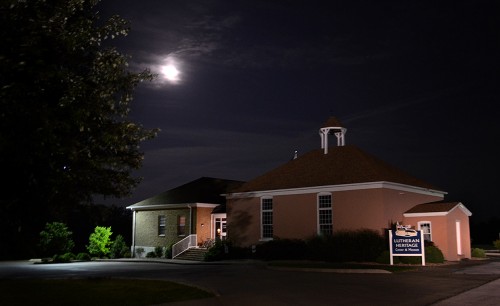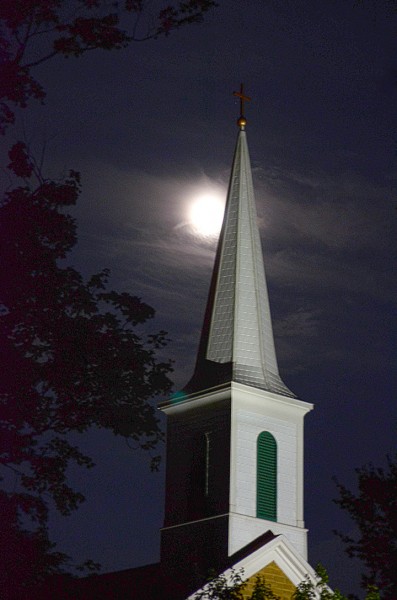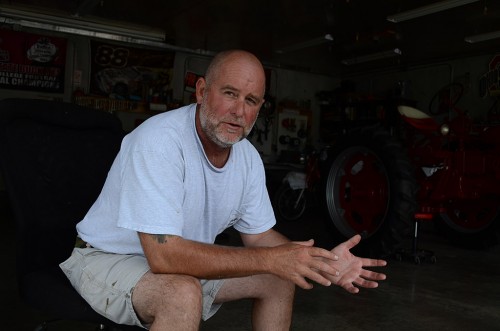 I wanted to see if I could find any trace of the house on Robinson Road where I photographed Bill Robinson and Jesse King in 1969. I drove the length of the short road and didn’t see a house like it, so I doubled back to see if any of the land forms were the same. I got no answer at the first two houses I tried. At the third, I was greeted by two dogs about half my size who threatened to lick me to death. A young man working on a bicycle pedal was almost as friendly as his dogs (except for the licking part), but he was of no help.
I wanted to see if I could find any trace of the house on Robinson Road where I photographed Bill Robinson and Jesse King in 1969. I drove the length of the short road and didn’t see a house like it, so I doubled back to see if any of the land forms were the same. I got no answer at the first two houses I tried. At the third, I was greeted by two dogs about half my size who threatened to lick me to death. A young man working on a bicycle pedal was almost as friendly as his dogs (except for the licking part), but he was of no help.
I drove down a lane and heard a dog barking inside a trailer. When I knocked on the door, the dog came charging down the hallway and launched himself at the window at about neck-high. They (a) didn’t need a doorbell and (b) probably didn’t have many door-to-door salesmen (who survived.)
I had better luck at the last house: Dave Allen was working out in his driveway. After I explained my mission, he thought he might have a vague recollection of the two men, but said his dad might be better able to help. He reached out for him on his cellphone. While we were waiting, Dave showed me two farm tractors he was restoring and told me that the Allen family had been living on that land since 1850. Nobody else’s name has ever been on it, he said.
Norm Allen
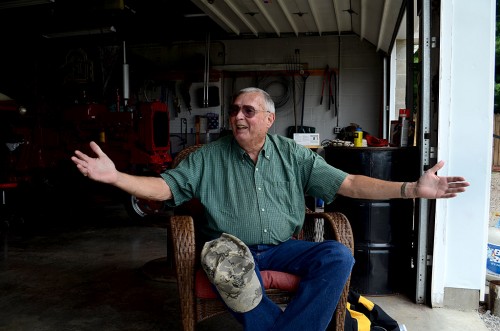
Norman K. Allen, 77, was a delight to talk with. He thought the house might have been one “just before you go down the steep hill with the curve. We didn’t go down there much.” He said it was possible the old house might have been reconfigured, but a second glance convinced us that it must have been replaced with a newer one if we were in the right place. (I’m not convinced we were. Some points of the terrain didn’t add up for me.)
Another Allen was fascinating: Capt. Josiah Benton Allen was one of the men responsible for the erection of the Civil War memorial on the Main Green at Ohio University. When he enlisted in the Union Army, his mother didn’t want him to go. “She chased him all the way from the house to the train,” Norm said. He was 19.
Capt. Allen lost arm at Vickburg
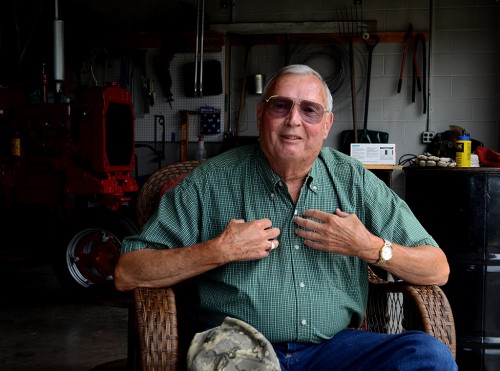 The information Dave and Norm provided pretty much dovetailed with a biography of Capt. Allen in the 1883 History of Hocking Valley: “July 4, 1861, he enlisted in Company C, Thirtieth Ohio Volunteer Infantry as a private. In April, 1862, he was promoted to First Orderly Sergeant. He participated in a number of battles and skirmishes, the most important being Giles Court-House, Carnitax Ferry, Second Bull Run, Centerville, South Mountain, Antietam, Haines’s Bluff, Jackson, Champion Hill, Black River and Vicksburg.
The information Dave and Norm provided pretty much dovetailed with a biography of Capt. Allen in the 1883 History of Hocking Valley: “July 4, 1861, he enlisted in Company C, Thirtieth Ohio Volunteer Infantry as a private. In April, 1862, he was promoted to First Orderly Sergeant. He participated in a number of battles and skirmishes, the most important being Giles Court-House, Carnitax Ferry, Second Bull Run, Centerville, South Mountain, Antietam, Haines’s Bluff, Jackson, Champion Hill, Black River and Vicksburg.
At the last, May 22, 1863, while storming Fort Gregg, he being in command of his company at the time, all but fourteen of his men were killed, he himself losing his left arm. After submitting to two amputations of the same arm, and being unfitted for service thereby, he was discharged for disability in 1861.
He returned to Athens and attended the Ohio University until the close of the college year in 1866, then went to Missouri and that fall was engaged in the insurance business. During the winter he taught school in the village of Maysville, of that State; returned to Athens in April, 1867, and the following fall was, without opposition, elected Recorder of Athens County on the Republican ticket. He held that office by being re-elected, for twelve years. From January to June, 1880, he held the stewardship of the Athens Asylum for the Insane. Losing that position through a change in the administration, he was appointed Recording Clerk in the office of the Secretary of State at Columbus, in December, 1880, remaining there until January, 1883.”
Historical treasure trove
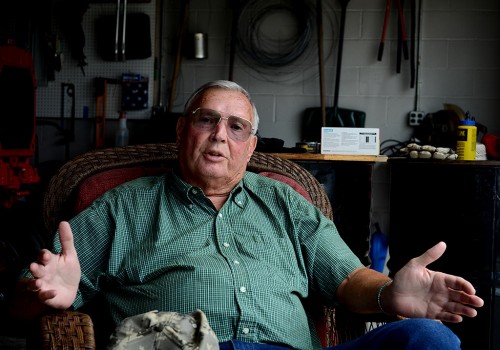 Saturday evening, I was meeting with some of the folks from the Athens Historical Society and Museum and giving them a recap of my day. “Does the name ‘Josiah Benton Allen’ mean anything to you?” I asked.
Saturday evening, I was meeting with some of the folks from the Athens Historical Society and Museum and giving them a recap of my day. “Does the name ‘Josiah Benton Allen’ mean anything to you?” I asked.
The room suddenly got quiet, then someone said, “Well, duh, yes. He was a big deal.”
“What would you say if I told you I spent two hours with his descendants. Oh, and by the way, they have his Purple Heart and some of his original correspondence?”
Saying something like that to historians elicits a Pavlovian response. “How did you meet these people?”
“Oh, just by knocking on doors. That’s what I used to do.”
(You can click on the photos to make them larger.)
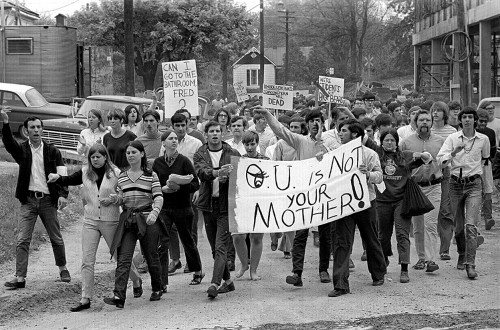 Friend and former Ohio University Post colleague Carol Towarnicky and I are going to do a presentation on the early days of the student rights movement to the OU History Association on October 24. It seems that stuff we covered as news has now become history. Or, as I like to say, “History is news with whiskers.”
Friend and former Ohio University Post colleague Carol Towarnicky and I are going to do a presentation on the early days of the student rights movement to the OU History Association on October 24. It seems that stuff we covered as news has now become history. Or, as I like to say, “History is news with whiskers.”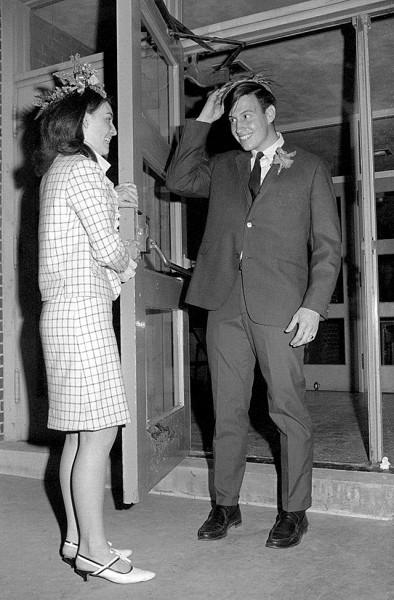 It was appropriate (and somewhat amusing) to run across these photos from Central’s 1967 TWIRP Dance while working on the OU show. This was the era of Sadie Hawkins Day dances (where the girl asks the boy for a date) and The Woman Is Requested to Pay (TWIRP) affairs.
It was appropriate (and somewhat amusing) to run across these photos from Central’s 1967 TWIRP Dance while working on the OU show. This was the era of Sadie Hawkins Day dances (where the girl asks the boy for a date) and The Woman Is Requested to Pay (TWIRP) affairs.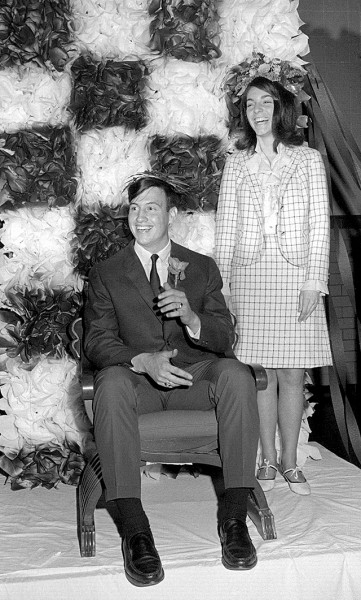 The story said Gary Littleton and Miss Mary Hirsch were crowned Mr. and Miss CHS at the Twirp Dance Friday night in the Central High School gymnasium.
The story said Gary Littleton and Miss Mary Hirsch were crowned Mr. and Miss CHS at the Twirp Dance Friday night in the Central High School gymnasium.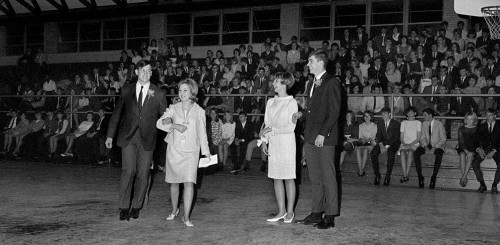 The candidates included Miss Jane Dunklin, daughter of Mr. and Mrs. Maurice Dunklin, 839 Alta Vista; Miss Mary Hale, daughter of Mr. and Mrs. Lemro Hale, 2209 Brookwood; Miss Georganne Penzel, daughter of Mr. and Mrs. George Penzel, 1844 Woodlawn; Charles McGinty, son of Dr. and Mrs. Charles McGinty, 2435 Brookwood; Larry Johnson, son of Dr. and Mrs. Earl Johnson, 1044 Henderson, and Mark Kirkpartrick, son of Mrs. Wilma Kirkpatrick, 903 Bellvue.
The candidates included Miss Jane Dunklin, daughter of Mr. and Mrs. Maurice Dunklin, 839 Alta Vista; Miss Mary Hale, daughter of Mr. and Mrs. Lemro Hale, 2209 Brookwood; Miss Georganne Penzel, daughter of Mr. and Mrs. George Penzel, 1844 Woodlawn; Charles McGinty, son of Dr. and Mrs. Charles McGinty, 2435 Brookwood; Larry Johnson, son of Dr. and Mrs. Earl Johnson, 1044 Henderson, and Mark Kirkpartrick, son of Mrs. Wilma Kirkpatrick, 903 Bellvue.




